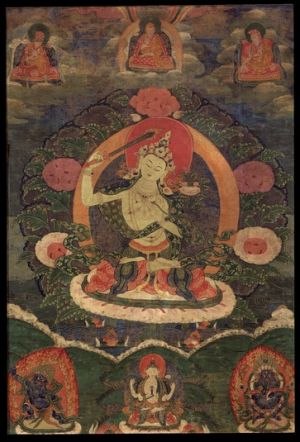Manjushri (Bodhisattva & Buddhist Deity) - Arapachana
Interpretation / Description
Arapachana Manjushri, white or orange (Tibetan: a ra pa cha na jam pal yang. English: Arapacana the Splendid Melodious Voiced One). The bodhisattva that represents the wisdom of all the buddhas of the ten directions and three times.
Sanskrit: Manjushri Tibetan: Jam pal yang
Beautiful and youthful, he has one face and two hands. The right holds aloft the blue flaming sword of wisdom severing ignorance. The left placed at the heart holds the stem of an utpala flower supporting on the blossom the Prajnaparamita book. Adorned with a crown of gold studded with jewels, earrings, necklaces and bracelets, he wears garments of silk, a green scarf and a red skirt. Seated with the legs folded in vajra posture atop a flat moon disc and flower blossom arisen from a lotus pond, he is surrounded by a blue-orange nimbus and red areola, completely engulfed in green foliage and flowers.
At the top center is a Sakya lama wearing the robes of a monk and a pandita hat with the lappets folded across the crown. The right hand held at the heart in blessing holds the stem of a lotus flower blossoming at the right ear. The left hand holds a book in the lap. At the left another lama appears in the same attire performing with both hands at the heart the Dharma Teaching mudra (gesture) while holding the stems of two lotus blossoms flowering at both ears. At the right a lama wearing monastic robes and a pandita hat performs the earth witness mudra with the right hand and the mudra of blessing held to the heart with the left.
At the bottom center is the bodhisattva of compassion Avalokiteshvara. With one face and four hands he holds a wishing jewel at the heart, in the second right a mala and in the left a lotus. At the left is the wrathful bodhisattva of power Vajrapani, dark blue, with one face and two hands holding a vajra upraised in the right and a lasso in the left, standing in a threatening manner surrounded by flames. At the right is the protector Panjarnata Mahakala, dark blue, with one face and two hands holding a curved knife and skullcup held to the heart with a stick lying horizontal.
Avalokiteshvara, Vajrapani and Manjushri represent the Three Families of Kriya Tantra and embody all of the compassion, power and wisdom of the buddhas. Manjushri has numerous forms both peaceful and wrathful in all the classifications of tantra from both the Nyingma and Sarma Schools. This form is the principal deity of the Siddhaikavira Tantra of the Kriya classification of Sarma. Highly regarded in the Sakya School all of the early lineage holders were regarded as emanations of the bodhisattva. And likewise all the Gongma Lamas of the Khon family, up to and including the present day, are regarded as emanations of Manjushri.
Lineage: Holy Manjushri, Mahasiddha Jetari, Ashokanta Shri, Vajrasana the Senior - Lalitavajra, the Younger - Amoghavajra, Bari Lotsawa, Tsechen Kunga Nyingpo, Sonam Tsemo,Dragpa Gyaltsen, Jamgon Sakya Pandita, Palchen Gvalo, etc.
Jeff Watt 4-98
Source
[[1]]
